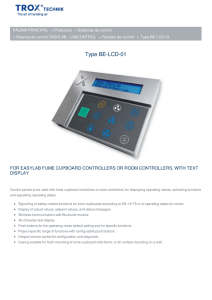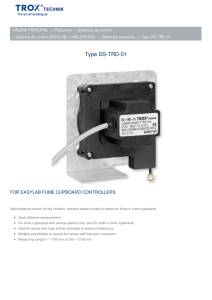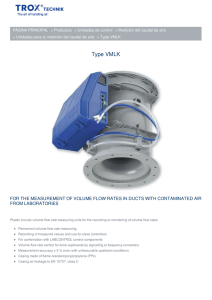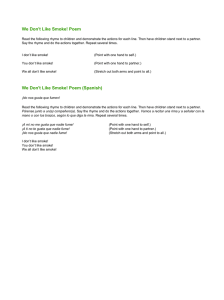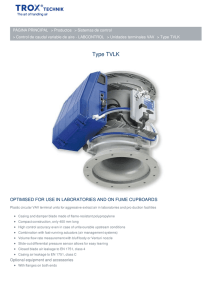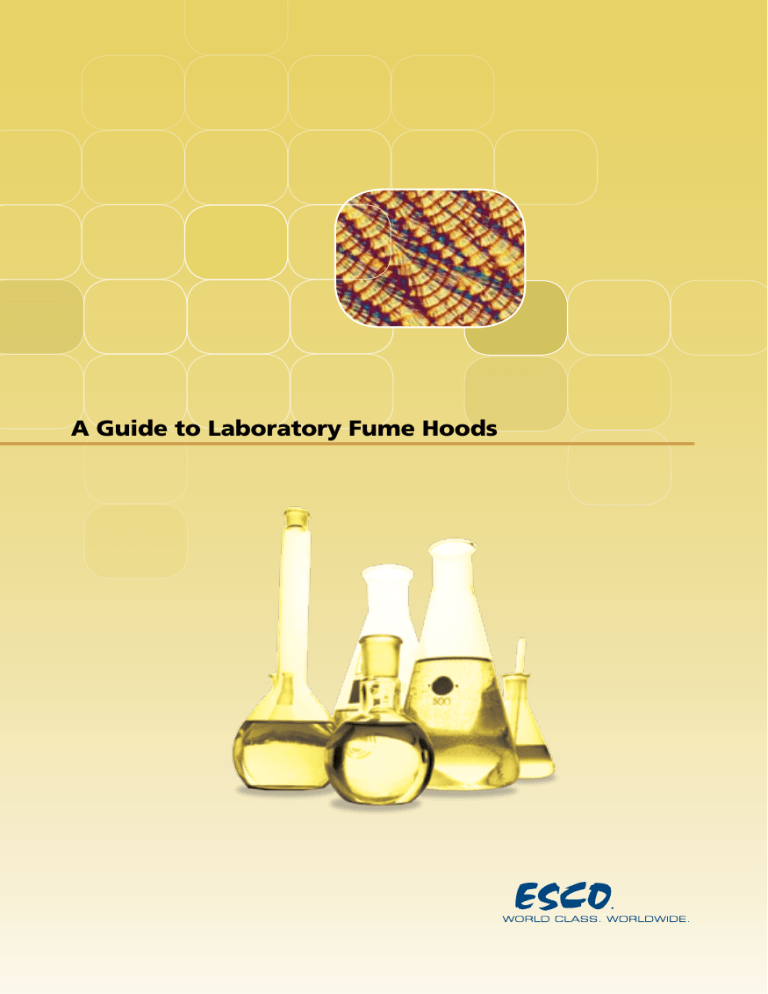
A Guide to Laboratory Fume Hoods INTRODUCTION Laboratory fume hoods are a type of ventilation system with the primary function to exhaust chemical fumes, vapors, gasses, dust, mist and aerosol. Fume hoods also serve as physical barriers between reactions and the laboratory, offering a measure of protection against inhalation exposure, chemical spills, run-away reactions and fires. A typical fume hood has a box like structure with a moveable sash window. Experimental procedures are performed within the hood which is consistently and safely ventilated, usually by means of an extract blower and ductwork. Chemical fumes are exhausted and diluted many times over in the atmosphere and have a negligible effect on human health. When environment concerns are of importance, an extract treatment system, often referred to as a scrubber is installed to remove most of the vapors from the exhaust air stream. 2 The hood functions by maintaining a relatively negative pressure in the interior of the hood to prevent any contaminant from escaping while drawing air in through the hood opening at a consistent rate. A suitable hood face velocity (the speed at which air is drawn into the hood) is of importance to the safe and effective operation of a fume hood. While excessive face velocities can often result in turbulence and reduce containment, insufficient velocities can also compromise hood performance. In general, a hood’s face velocity is recommended to be between 0.3 m/s (60 fpm) and 0.5 m/s (100 fpm), however it is important to check with local safety regulations on the face velocity recommendation before using the fume hoods. Most hoods are commonly sized for a minimum face velocity at full sash opening; but as means to conserve energy some hoods size the minimum face velocity of the hood at half-sash opening creating new low flow fume hoods, which are now present in the market. Types of Fume Hoods • General Purpose, Bench Top Fume Hood • Distillation Fume Hood A distillation hood is characterized by a low worktop height which results in a large working height for the operator. This allows tall distillation equipment to be installed and mounted in the work chamber. Otherwise, it has similar features to that of a standard fume hood. • Perchloric Acid Fume Hood Perchloric acid reacts violently with organic materials. Dried perchloric acid is also highly explosive. Therefore, perchloric fume hoods require built-in water wash down systems in order to prevent perchlorate salt deposits. Interior liners are made of acid resistant materials like stainless steel. Interior corners are coved to aid in cleaning. All procedures that use perchloric acid must be confined to a perchloric fume hood, to prevent dangerous reactions with other chemicals. A Guide to Laboratory Fume Hoods • Introduction • Radioisotope Fume Hood Radioisotope fume hoods are constructed specifically to protect users from radioactive materials. They have specially constructed worktops to withstand the weight of lead shielding plates, and may also have lead laced sashes. Interiors are made of stainless steel with coved corners to aid in decontamination. • Acid Digestion Fume Hood Acid digestion fume hoods have special liners manufactured of acid resistant materials such as unplasticized PVC. For acid digestion applications involving high service temperatures, other materials such as PVDF may be used. Sashes may be made of polycarbonate to resist hydrofluoric acid etching. • Floor Mounted Fume Hood Floor mounted fume hoods are used for applications which require large apparatus. As the name implies, these hoods are floor mounted without any work surface. This facilitates the transfer of equipment and materials into, and out from the hood. Floor mounted hoods are sometimes referred to, although wrongly, as walk-in fume hoods. • Demonstration Fume Hood A demonstration hood has all 4 sides made of safety glass, and this hood is commonly used in educational institutions to allow students to easily view the teachers’ demonstrations inside the fume hood from all angles, enhancing efficiency in teaching laboratories. • Ductless Fume Hood Ductless fume hoods utilize activated carbon filtration to adsorb chemical vapors and fumes. These hoods recirculate air to the laboratory, and are growing in popularity because of energy savings and the green movement. Not Fume Hoods Biological safety cabinets, laminar flow clean benches, pharmacy isolators and glove boxes are sometimes mistaken for fume hoods. These devices utilize particulate filters which do not remove chemical vapors. With specific rare exceptions, they should not be used for work involving chemicals. 3 Important components of a Fume Hood 6 2 3 1 7 4 4 5 1. Hood Body The visible part of the fume hood that serves to contain hazardous gases and vapors. 2. Baffles Moveable partitions used to create slotted openings along the back of the hood body. Baffles keep the airflow uniform across the hood opening, thus eliminating dead spots and optimizing capture efficiency. 3. Sash The sliding “door” to the hood. By using the sash to adjust the front opening, airflow across the hood can be adjusted to the point where capture of contaminants is maximized. Each hood has its optimum sash configuration. The sash should be held in this position when working in the hood and closed completely when the hood is not in use. The sash may be opened completely to set up equipment, but must be returned to the optimum setting prior to generating contaminants inside the hood. Hoods are equipped with one of three types of sashes: • Vertical Vertical sashes provide the greatest overall access and are the most common. A Guide to Laboratory Fume Hoods • Important Components of a Fume Hood • Horizontal Horizontal sashes provide the best access to the top interior of the hood, but do not provide access to the entire width at the same time. However, they can be positioned as a body shield to protect the operator, while enabling access through the sides. • Combination vertical and horizontal Combination sashes combine horizontal sash panes, in a vertical rising frame. As such, they offer the advantages of both vertical and horizontal sashes. 4. Airfoil Located along the bottom and side edges the airfoil streamlines airflow into the hood, preventing the creation of turbulent eddies that can carry vapors out of the hood. The space below the bottom airfoil provides source of room air for the hood to exhaust when the sash is fully closed. Removing the airfoil can cause turbulence and loss of containment. 5. Work surface Generally a laboratory bench top, or the floor in the case of a floor-mounted hood, this is the area where the work is conducted. 6. Exhaust plenum The exhaust plenum helps distribute airflow evenly across the hood face. Materials such as paper towels drawn into the plenum can create turbulence in this part of the hood, resulting in areas of poor airflow and uneven performance. 7. Face The imaginary plane between the bottom of the sash and the work surface. Hood face velocity is measured across this plane. 5 Important Facts about Laboratory Fume Hoods Fume hoods should be suitably sited to ensure maximum containment. Locate hoods to avoid crosscurrents at the hood face due to pedestrian traffic, doors and supply air diffusers. Sufficient laboratory supply air must be available to allow hoods to operate at their specified face velocities. A fume hood is not designed to contain high velocity releases of particulate contaminants unless the sash is fully closed. The hood is not capable of containing explosions, even when the sash is fully closed. If an explosion hazard exists, the user should provide anchored barriers, shields or enclosures of sufficient strength to deflect or contain it. Such barriers can significantly affect the airflow in the hood. 6 A conventional fume hood must not be used for perchloric acid. Perchloric acid vapors can settle on ductwork, resulting in the deposition of perchlorate crystals. Perchlorates can accumulate on surfaces and have been known to detonate on contact, causing serious injury to researchers and maintenance personnel. Specialized perchloric acid hoods, made of stainless steel and equipped with a wash down system must be used for such work. Many fume hoods are equipped with flat or rounded sills or air foils which direct the flow of air smoothly across the work surface. Sills should not be removed or modified by the hood user. Objects should never be placed on these sills. Materials released from containers placed on the sills may not be adequately captured. In addition, an object on the sill may prevent the quick and complete closure of the sash in an emergency. Tubing is frequently used to channel exhaust to the hood from equipment located some distance away. This is not an effective control method. Occasionally, a researcher may need local exhaust ventilation other than that provided by an existing fume hood. A new device may not be connected to an existing fume hood without the approval of the manufacturer. Adding devices to even the simplest exhaust system without adequate evaluation and adjustment will usually result in decreased performance of the existing hood and/or inadequate performance of the additional device. Work involving harmful microorganisms should be done in a biosafety cabinet, rather than a chemical fume hood. A fume hood should not be used for waste disposal. It is a violation of environmental regulations to intentionally send waste up the hood stack. A Guide to Laboratory Fume Hoods • Important Facts About Laboratory Fume Hoods Guidelines for Using a Fume Hood Effectively Adequate planning and preparation is the key. The hood user should know the Standard Operating Procedure (SOP) of the hood and should design experiments so that the SOP can be maintained whenever hazardous materials might be released. Look for process changes that improve safety and reduce losses to the environment (e.g. more accurate chemical delivery systems vs. pouring volatile chemicals from bottles). Develop a process to evaluate research proposals ahead of time for potential emissions and look for opportunities to reduce them. The level of protection provided by a fume hood is affected by the manner in which the fume hood is used. No fume hood, however well designed, can provide adequate containment unless good laboratory practices are used, as follow: • Ensure the exhaust is operating before beginning work. Check the baffles for obstructions. If the hood is fitted with an airflow monitor, check the monitor’s status. Even while working, be alert to changes in airflow. • When using the fume hood, keep your face outside the plane of the hood. Use the sash for partial protection during hazardous work. •• Work at least 6 inches back from the face of the hood. A stripe on the bench surface is a good reminder. •• Use appropriate personal protective equipment such as splash goggles and gloves. This enhances safety in case of catastrophic spills, run-away reactions or fire. Wear a full face shield if there is possibility of an explosion or eruption. •• When using large apparatus inside the hood, place the equipment on blocks, when safe and practical, to allow air flow beneath it. •• Do not make quick motions into or out of the hood, use fans, or walk quickly by the hood opening. These will cause airflow disturbances which reduces the effectiveness of the hood. •• Substitute with less hazardous or less volatile chemicals where possible. •• The hood should be kept closed, except during apparatus set-up or when working within the hood is necessary. •• Keep the hood sash closed as much as possible to maximize the hood’s performance. •• Keep the sash closed when not in use to maximize energy conservation. •• If performance is suspected, or an airflow alarm is triggered (if installed), terminate usage, and close the sash completely. •• Items contaminated with odorous or hazardous materials should be removed from the hood only after decontamination or if placed in a closed outer container to avoid releasing contaminants into the laboratory air. 7 Risks Involved with the Improper Use of Fume Hoods A fume hood is a piece of safety equipment that can be misused to the extent that they can be less effective than expected. Injury from misuse can arise from two causes: •• From the fume hood not providing adequate flow rates for the work required (i.e. sash being left open or from excess clutter that reduces the containment of noxious substances). •• From the hood itself (i.e. if the fan belts are slipping, the exhaust duct has blockage due to paper towels being sucked into the duct, the duct damper is restricted). Always realize the most likely person to be injured is the hood user. Escaping noxious material into the laboratory can also affect all laboratory occupants. A. Power Outages In case of a power outage, the hood sash should be lowered within an inch to maintain a chimney effect to keep some air flowing into the hood. 8 B. Exhaust Care should be taken with use of paper products, aluminum foil, and other lightweight materials within a hood. For example, a single paper towel or chemical wipe can potentially decrease the airflow into the hood if it restricts exhaust flow. Good HouseKeeping Practices in a Laboratory using Fume Hoods •• •• •• •• •• Do not use the hood as a waste disposal mechanism. Apparatus used in a hood should be fitted with condensers, traps, or scrubbers to contain and collect waste solvents, toxic vapors or dust. Proper disposal of waste and code compliance should be practiced. Limit chemical storage in fume hoods. Keep the smallest amount of chemicals in the hood needed to conduct the procedure at hand. Do not use the hood as a storage area. Items can block airflow and interfere with containment. Store hazardous chemicals such as flammable liquids in an approved safety cabinet. Do not leave uncapped bottles of reagents in a hood. Although a hood is used to exhaust fumes out of the laboratory, minimizing the amount of evaporation and fuming is desirable for the environment and operator safety. Always use good housekeeping techniques to maintain the hood at optimal performance levels. Excessive storage of materials or equipment can cause eddy currents or reverse flow resulting in contaminants escaping from the hood. A Guide to Laboratory Fume Hoods • Risks Involved With The Improper Use of Fume Hoods Testing and maintenance of Fume hood •• Hoods should be evaluated by the user before each use to ensure adequate face velocities and the absence of excessive turbulence. •• In case of exhaust system failure while using a hood, shut off all services and accessories and lower the sash completely. Leave the area immediately. •• Fume hoods should be certified, at least annually, to ensure they are operating safely. Typical tests include face velocity measurements, smoke tests and tracer gas containment. Tracer gas containment tests are especially crucial, as studies have shown that face velocity is not a good predictor of fume hood leakage. In fact, these same studies have shown that approximately a third of fume hoods in use in the US, fail to meet the safety criteria specified in ANSI Z9.5. •• Laboratory fume hoods are one of the most important used and abused hazard control devices. We should understand that the combined use of safety glasses, protective gloves, laboratory smocks, good safety practices, and laboratory fume hoods are very important elements in protecting us from a potentially hazardous exposure. •• Laboratory fume hoods only protect users when they are used properly and are working correctly. A fume hood is designed to protect the user and room occupants from exposure to vapors, aerosols, toxic materials, odorous, and other harmful substances. A secondary purpose is to serve as a protective shield when working with potentially explosive or highly reactive materials. This is accomplished by lowering the hood sash. Misconceptions Associated with Fume Hoods • When working with highly hazardous materials, the higher the face velocity the better. While it is important to have a face velocity between 0.3 m/s (60 fpm) and 0.5 m/s (100 fpm), velocities higher than this are actually harmful. When face velocity exceeds 0.6 m/s (125 fpm) eddy currents are created which allow contaminants to be drawn out of the hood, increasing worker exposures. Check with local safety regulations on the maximum face velocity before using the hood. • A chemical hood can be used for storage of volatile, flammable, or odiferous materials when an appropriate storage cabinet is not available. While it is appropriate to keep chemicals that are being used during a particular experiment inside the chemical hood, hoods are not designed for permanent chemical storage. Each item placed on the work surface interferes with the directional airflow, causing turbulence and eddy currents that allow contaminants to be drawn out of the hood. Even with highly volatile materials, as long as a container is properly capped evaporation will 9 not add significantly to worker exposures. Unlike a chemical hood, flammable materials storage cabinets provide additional protection in the event of a fire. • The airfoil on the front of a hood is of minor importance. It can safely be removed if it interferes with my experimental apparatus. Airfoils are critical to efficient operation of a chemical hood. With the sash open an airfoil smoothes flow over the hood edges. Without an airfoil eddy currents form, causing contaminates to be drawn out of the hood. With the sash closed, the opening beneath the bottom airfoil provides for a source of exhaust air. Salient Feature of Esco’s Fume Hoods 10 (Left to Right) Frontier® Acela Fume Hood, Frontier® PVC Acid Digestion Fume Hood, Frontier® Radioisotope Fume Hood, Frontier® Floor Mounted Fume Hood and Frontier® Perchloric Fume Hood •• Industrial-grade support structure constructed of electro-galvanized steel and aluminum with corrosion and abrasion resistant oven-baked powder-coated finish. Internal liner is constructed of phenolic resin laminates; more corrosion-resistant and durable than other common internal liner materials. Single wall design ensures the internal work zone width is maximized. •• Instant-start electronically ballasted 5000k lighting system is flicker-free and the warm glow of the lighting system is comfortable to the operator’s eyes during extended hours of usage. Integral fluorescent lighting is isolated from the air stream in order to increase airflow uniformity. A Guide to Laboratory Fume Hoods • Salient Features of Esco’s Fume Hoods •• Standard vertical rising fail-safe counterbalanced sash. The sash will tilt and lock if a cable snaps; all sashes are constructed of tempered glass for maximum operator safety. State-of-the-art baffle system constructed of phenolic resin laminates delivers maximum containment by ensuring airflow uniformity throughout the main chamber of hood. •• Aerodynamic design eliminates air turbulence within the hood which can otherwise compromise containment; noise levels and static pressure losses are also minimized. Aerodynamic curved side profile improves containment. Corrosion-resistant stainless steel airfoil provides spill retention and safely ventilates fumes generated towards the front of the hood for superior operator protection; the curved front edge also facilitates an ergonomic working position. •• Generously-sized work zone due to improved positioning of the service fixtures. Black color work surface resists staining. No exposed metal screws are present in the work zone construction, which improves corrosion resistance of the body. Electrical system is designed to meet the latest international regulations and standards for safety. •• Independently certified to the latest safety and performance requirements of the ANSI/ ASHRAE Standard 110-1995. •• The ANSI/ASHRAE 110 is the American standard test method for fume hoods. Esco possesses test laboratories in Asia capable of performing the full set of ASHRAE tests using an electron capture and SF6 as a tracer gas. All test results are captured via a sophisticated computer logger. Laboratory conditions can also be controlled to simulate real world operating conditions and airflow disturbances. Esco’s laboratory is also equipped with instruments to perform air velocity and smoke visualization. Esco uses the ANSI / ASHRAE 110 protocol to evaluate the performance of new fume hood designs and as a quality control measure. •• The KI-Discus test is an alternative method for evaluating fume hood containment. The advantage of this test is that it can be readily performed in the field (unlike the ANSI / ASHRAE 110 test method which requires an expensive and usually non-portable source of SF6 gas) with a mobile test kit. This test has already gained wide acceptance in Europe, especially the UK, and was originally pioneered for use on safety cabinets. 11 Airflow Alarms and Monitors • Benchtop Laboratory Fume Hoods Biological • High Safety Cabinets Performance Low • Exhaust Blowers Flow Fume Hoods Esco Technologies, Inc. • 2940 Turnpike Drive, Units 15-16 • Hatboro, PA 19040, USA Toll-Free USA and Canada 877-479-3726 • Tel 215-441-9661 • Fax 215-441-9660 us.escoglobal.com • [email protected] Esco Micro Pte. Ltd. • 21 Changi South Street 1 • Singapore 486 777 Tel +65 6542 0833 • Fax +65 6542 6920 • [email protected] www.escoglobal.com Esco Global Offices | Beijing, China | Kuala Lumpur, Malaysia | Manama, Bahrain | Guangzhou, China | Hanoi, Vietnam | Melaka, Malaysia | Mumbai, India | Philadelphia, PA, USA | Salisbury, UK | Shanghai, China | Seoul, Korea | Delhi, India | Osaka, Japan | Manila, Philippines | Midrand, South Africa | Jakarta, Indonesia | Singapore . escoglobal com LIVE SUPPORT Esco Micro Pte Ltd Cert. No: 651076 PT Esco Bintan Indonesia Cert. No: 651333/E 9010046_Fumehood_Guide_to Laboratory Fumehoods_A5_vC1_02/12 Esco can accept no responsibility for possible errors in catalogues, brochures and other printed materials. Esco reserves the right to alter its products and specifications without notice. All trademarks and logotypes in this material are the property of Esco and the respective companies. Since 1978, Esco has emerged as a leader in the development of controlled environment, laboratory and pharmaceutical equipment solutions. Products sold in more than 100 countries include biological safety cabinets, fume hoods, ductless fume hoods, laminar flow clean benches, animal containment workstations, cytotoxic cabinets, hospital pharmacy isolators, and PCR cabinets and instrumentation. With the most extensive product line in the industry, Esco has passed more tests, in more languages, for more certifications, throughout more countries than any biosafety cabinet manufacturer in the world. Esco remains dedicated to delivering innovative solutions for the clinical, life science, research and industrial laboratory community. www.escoglobal.com.


